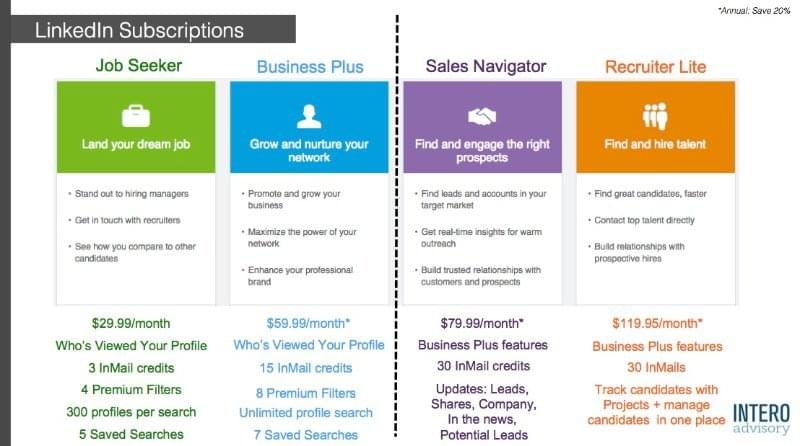5 Things Recruiters Need to STOP Doing in 2016
1. Talking about “Employer” Branding
 When the concept of employer branding was first introduced, many companies couldn’t wait to start rolling out video after video, telling us how amazing they are and why it’s so wonderful to work for them.
When the concept of employer branding was first introduced, many companies couldn’t wait to start rolling out video after video, telling us how amazing they are and why it’s so wonderful to work for them.
Take this “lovely” video, with cool graphics and a non-descript American voice narrating it, for example. It’s ultimately forgettable, boring and it’s not representative of the brand – Mars are renowned for innovative, creative and funny advertising and this is just not it…
When the second generation of employer branding rolled around, we started to see more and more companies include their employees in their employer branding efforts (so far so good), but instead of letting those employees tell their own stories about the company, they asked those employees to tell everyone why their company is so great. Take this video, which showcases scientists from AstraZeneca, for example. Here’s a bunch of AstraZeneca employees talking about their work…. oh, and just how amazing AstraZeneca are. *Yawn*
Well, here’s the cold hard truth those companies need to hear: no one cares about your company or how great you think it is to work there. What they really want to know is how your company’s employees think it is to work there. OF COURSE, you think it’s fabulous to be an employee, after all you’re trying to get more people in the door so that the company can continue being profitable. Potential candidates know this. Your efforts to convince them are never going to hold as much water, as an actual honest-to-goodness employee telling them, in their own words, that actually, your company is a pretty sweet place to work.
Therefore, you need to start thinking less about “Employer” branding and focusing more on “Employee” branding.
Instead, try: Talking about “Employee” Branding
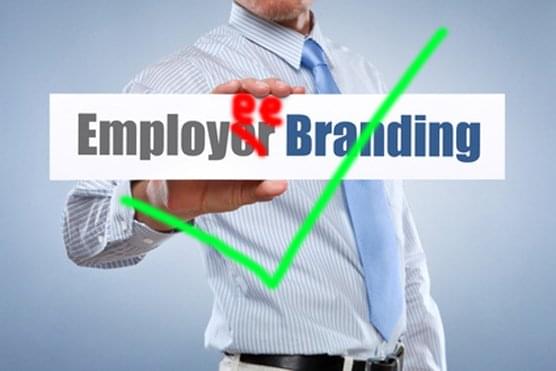 “So, if we’re not going to tell them how good we think our company is, how do we get people to care about our organisation, or the fact that we’re hiring?!” I hear you ask. The answer: You have to make them feel something about your company and in order to make them feel something you have to pull on their emotional strings.
“So, if we’re not going to tell them how good we think our company is, how do we get people to care about our organisation, or the fact that we’re hiring?!” I hear you ask. The answer: You have to make them feel something about your company and in order to make them feel something you have to pull on their emotional strings.
Here comes the science part! According to the research findings of Chip and Dan Heath, the authors of Made to Stick, human beings are hard-wired to feel things about people, not abstractions. That simply means that it’s easier for us to have emotional thoughts and feelings towards other people than it is to other things. Therefore, in order to make people care about something (in your case, your organisation and the fact that you’re hiring), you have to bring people into the equation. But, just bringing in people is not enough, as we learned from the AstraZeneca example.
You need to let your people tell stories – their own stories. Chip and Dan Heath’s research also tells us that the right stories make people act, which as recruiters, is exactly what we need them to do. We need them to act by submitting an application to the job we’re offering.
Stories act as mental flight simulators. They are the closest thing to the real thing. By telling a story, we are able to put somebody into the shoes of that role and help them experience life in your company. To make them feel like they’re part of your organisation.
A great example of a company that has used it’s employees own stories to boost their employer brand is Deloitte:
Here, Deloitte have used a creative agency to do a mini-documentary on David (and 6 other graduates). Instead of the usual/predictable employer branding video detailing how ‘great’ the company is and how ‘fun’ it is to work there, Deloitte decided to make their current cohort of interns, the stars of the show. They introduce humour, they showcase their experience with the Deloitte internship process so far and what they hope to achieve from it. They give an insight into the day-to-day life of a Deloitte intern (who is the same age as those he’s meant to engage to apply for jobs!) including snippets of the work, the offices, the desks, the equipment and the general look and feel of the Deloitte environment. Not once is Deloitte’s branding or cultural message shoved down your throat or forced upon you. It’s about the employee’s journey, not the company’s top-down “why our culture is great” strategy that the previous employer branding efforts we’ve seen, have ended up being.
Similarly, when it came to producing our own employer branding videos, we wanted to take a step away from the norm and do something a little different from the now standard corporate “look at how great our company is” video too. Our aim with our videos, was to show off how awesome it really is to work at Social Talent, which we figured was best demonstrated by the people that work here: our employees. Here at Social Talent we have an array of talented, creative, interesting people, all with their own quirky personalities, so what better way to let the world know that, than to give each of them some air time! They gave us insights into each of their individual personalities and, in turn, let everyone know what the culture here at Social Talent HQ is really like. Check out Nicola’s video for example:
2. Using free LinkedIn
 It’s 2016, if you’re a serious recruiter you need to stop trying to “beat the system” and using every trick in the trade to get around having to pay for LinkedIn. Yes, we’re very well aware that there is a hack for pretty much everything on LinkedIn (heck, we’ve even invented some ourselves), but using these hacks to find candidates in the long term takes far too much time and effort – time and effort that could be spent doing far more productive tasks.
It’s 2016, if you’re a serious recruiter you need to stop trying to “beat the system” and using every trick in the trade to get around having to pay for LinkedIn. Yes, we’re very well aware that there is a hack for pretty much everything on LinkedIn (heck, we’ve even invented some ourselves), but using these hacks to find candidates in the long term takes far too much time and effort – time and effort that could be spent doing far more productive tasks.
According to our research, LinkedIn is the most used recruiting platform amongst recruiters (96% of you use it to find candidates on a daily basis), while a whopping 37% of you told us it was your primary source for finding candidates “who were ultimately hired”. Therefore, in our opinion, LinkedIn are perfectly entitled to ask you to pay a (relatively small) fee for the service they provide you.
If you’re still not convinced, we also have conducted research which proves that users of paid LinkedIn accounts are actually more competent sourcers than those who use a basic account…
Try instead: Paying for the most basic level of LinkedIn
 In the past, it has been hard to get a grip on exactly which paid account is best for recruiters. Thankfully, LinkedIn did become aware of that fact in the last year and have done their best to make the process as simplified as possible. Here are the facts.
In the past, it has been hard to get a grip on exactly which paid account is best for recruiters. Thankfully, LinkedIn did become aware of that fact in the last year and have done their best to make the process as simplified as possible. Here are the facts.
There are 4 types of paid LinkedIn subscription:
- Job Seeker
- Business Plus
- Sales Navigator
- Recruiter Lite
Luckily for us, Lindsey Stemann has drawn up a graphic that explains exactly what each offering will cost you and what you will receive for your money:
Let’s dive into what each of these paid features actually means for you:
- Who’s Viewed Your Profile: While a free accounts lets you see a handful a people who have viewed your profile, the vast majority of this information is hidden from you, meaning you don’t get a complete picture of who has been viewing your profile. Why is this important? Well, if you’re a recruiter it’s exceptionally important for you to know whether or not the candidate you just reached out to has visited your profile to check you out, and in doing so, shown some interest in the role you’re proposing. When you notice a candidate has visited your profile, it’s the perfect time of you to take action on that activity by reaching out to them and starting a conversation.
- InMail Messages: LinkedIn InMail messages have an a staggering 85% open rate – 3 times higher than that of traditional email – so having access to more InMails means you have more chance of receiving a response from the candidates you do reach to (depending on how well you write your InMail). Plus, if the recipient accepts or declines your InMail within 90 days, LinkedIn will credit the InMail back to you.
- Premium Search Filters: Paying for LinkedIn will give you access to some useful search filters you can use to refine your candidate search and get to the right people more quickly. These include; seniority level, company size, interests, Fortune 1000, job function, years of experience, additional information about your groups and who is new to LinkedIn – filters you won’t be able to utilise with a free account.
- Profiles Per Search: This is the biggie! Last year LinkedIn allowed Basic (free) members access to 3rd-degree profiles, but as we all know this access came at an expense – the dreaded commercial search limit. As of the date this blog was posted, there is no commercial search limit when you upgrade to the Business Plus subscription or higher.
- Saved Search Alerts: The Saved Search Alerts are one of (three) emails you don’t want to miss in your inbox. LinkedIn will email you any new profiles that fit your search criteria on a weekly basis. So, LinkedIn will email you leads? Yep, you got it.
As a recruiter, we suggest selecting the Business Plus option to start with, but if you feel like pushing the boat out, definitely check out the Recruiter Lite option which is specifically tailored to those in recruitment and offers you more ATS-like abilities within LinkedIn itself.
3. Using corporate speak in your job specs
 This needs to stop and it needs to stop NOW. Using jargon in your job specs does not make you look clever, nor does it make your open job role more enticing. In fact, quite the opposite is true. According to Jennifer Chatman, Management Professor at the University of California, Berkeley (Haas School of Business), “jargon masks real meaning” and acts as a barrier between individuals. And the last thing you need between you and the right candidate is a barrier!
This needs to stop and it needs to stop NOW. Using jargon in your job specs does not make you look clever, nor does it make your open job role more enticing. In fact, quite the opposite is true. According to Jennifer Chatman, Management Professor at the University of California, Berkeley (Haas School of Business), “jargon masks real meaning” and acts as a barrier between individuals. And the last thing you need between you and the right candidate is a barrier!
When we decided to conduct our own online poll across Facebook, LinkedIn and Twitter to discover which words/phrases make recruiters’ blood boil, we were astonished at the vast number of words/phrases they were able to ream off as being offensive yet commonplace within the industry:
![]()
![]()
![]()



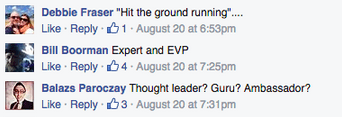
![]()
The thing is, if your words don’t provoke the positive response you want, something isn’t working and when it comes to job ads, the most likely issue is the words you’ve used to describe the role. It’s time to shake things up!
Try instead: Using some emojis and talking like a human being
 Like them or loathe them, emojis have become an integral part of everyday conversation and engagement, therefore it makes sense to us for recruiters to start using them on an informal basis within recruitment. In fact, there has been a lot of research into the benefits of using emojis in your communications, the most notable of which has been L’Oreal’s research into recruiting with emojis.
Like them or loathe them, emojis have become an integral part of everyday conversation and engagement, therefore it makes sense to us for recruiters to start using them on an informal basis within recruitment. In fact, there has been a lot of research into the benefits of using emojis in your communications, the most notable of which has been L’Oreal’s research into recruiting with emojis.
They began working with the colourful little images first, by asking their own employees to describe their job using only emojis. Here’s an example:

The promotion proved popular, which caused L’Oreal’s Vice President of Global Talent Acquisition, Frederique Scavennec and Head of Talent Acquisition Lab, Zvi Goldfarb, to ask “why keep this internal?!” So they asked the public to describe their dream job in a tweet, using only emojis, and the response was impressive. Here’s an example of the type of tweets they got:
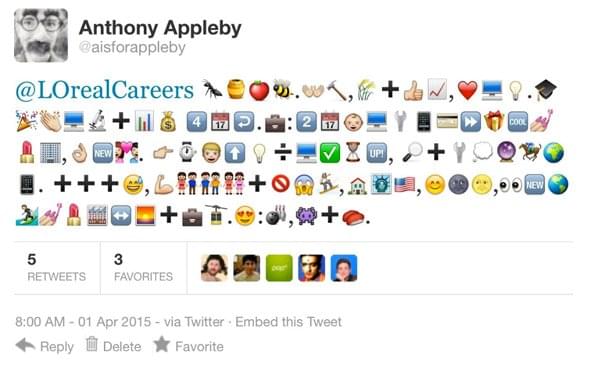
Which means the following (in case you’re not fluent in emoji!):
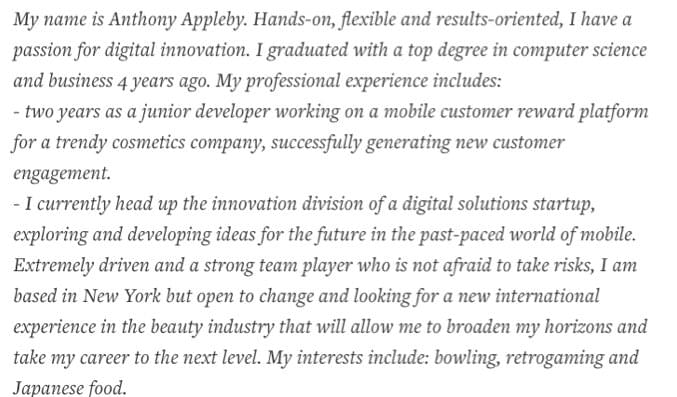
The campaign proved a clever way to build buzz about L’Oréal and its recruiting team, while continuing to brand the company as an innovative and creative place to work – quite powerful for colourful little faces don’t you think?!
- How would I explain this job to my 6 year old? Asking yourself this will force you to simplify your explanation and cut out any overly complicated words.
- What is the dictionary definition of this buzzword? Asking yourself this will force you to clarify the meaning of the word you’re using. In some cases you may find the word has nothing to do with what you want to say.
- How else can I say this? We do this all the time when we find synonyms to use in our Boolean search strings, so do your best to think of other, less complicated, ways to phrase what you’re trying to say.
- Is there a story/analogy to better support my words? As I explained in point number one, stories motivate people to take action, so always turn elements of your job ad into a story where you can.
As recruiters, we must constantly test our audience of candidates to determine which words/phrases bring them to action i.e. apply for the job, and which words/phrases shut them down i.e. turn them away.
4. Jumping on every bandwagon going
 We’ve all seen the headlines: Job boards are dead. Twitter is dead. ATS is dead. Boolean is dead. Blogging is dead. Pretty much everything is “dead” according to the internet. Why is it dead? Because by creating a piece of content with a title like that, you’re bound to get people clicking on it to see what all the fuss it about. It’s called click bait. And there’s no problem with it, except for the fact that it very often plants a seed in people’s heads and causes them to change the way they think and act, sometimes for worse.
We’ve all seen the headlines: Job boards are dead. Twitter is dead. ATS is dead. Boolean is dead. Blogging is dead. Pretty much everything is “dead” according to the internet. Why is it dead? Because by creating a piece of content with a title like that, you’re bound to get people clicking on it to see what all the fuss it about. It’s called click bait. And there’s no problem with it, except for the fact that it very often plants a seed in people’s heads and causes them to change the way they think and act, sometimes for worse.
Pretty much everything is “dead” according to the internet. Why is it dead? Because by creating a piece of content with a title like that, you’re bound to get people clicking on it to see what all the fuss it about. It’s called click bait – a tactic content marketing professionals (including myself) use to get people to click through and read their articles, download their whitepapers and quote their studies. And there’s no problem with it, except for the fact that by making such bold statements, it very often plants a seed in people’s heads and causes them to change the way they think and act, sometimes for worse.
But here’s the thing: just because you’ve read somewhere that job boards are dead, doesn’t necessarily mean that they are. Sure, they might not be the way the author of the article/study/whitepaper is finding their best candidates anymore, but they still might be the best place for YOU to find candidates. The same is true for Twitter. Just because someone else has decided they’re not reaching the candidates they need to on it, does not mean you won’t either. Heck, lots of people have said blogging is dead, yet here you are reading this!
Just because someone says something is not working for them, doesn’t mean it won’t work for you.
Try instead: Running your own experiments
 You can find data on pretty much everything these days. So, stop blindly following every piece of research out there and try running some experiments of your own. If you think job boards are dead, test it! Try placing an ad on one and placing the same ad elsewhere like Twitter or LinkedIn. Which source gets you the most high-quality responses? Think Twitter isn’t working? Take a look your analytics! Maybe all you need to do is change up the way you’re wording your tweets or the hashtags your using or the time you’re posting your tweets. Do what marketers do and split test different tweets, then use your Twitter analytics to determine which tweet got the most replies, likes or retweets.
You can find data on pretty much everything these days. So, stop blindly following every piece of research out there and try running some experiments of your own. If you think job boards are dead, test it! Try placing an ad on one and placing the same ad elsewhere like Twitter or LinkedIn. Which source gets you the most high-quality responses? Think Twitter isn’t working? Take a look your analytics! Maybe all you need to do is change up the way you’re wording your tweets or the hashtags your using or the time you’re posting your tweets. Do what marketers do and split test different tweets, then use your Twitter analytics to determine which tweet got the most replies, likes or retweets.
Test, test, test!
5. Using social media as a bulletin board
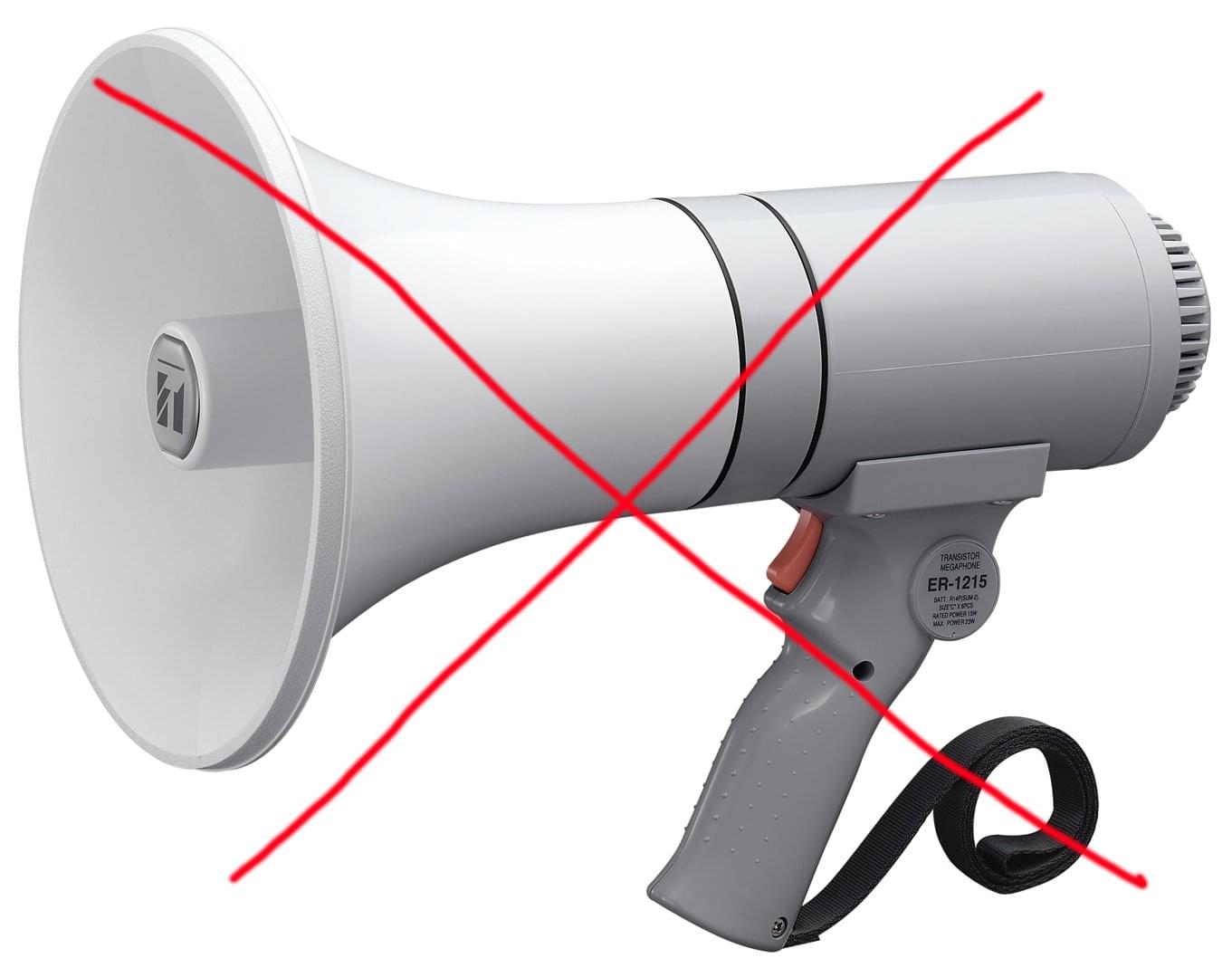 You wouldn’t walk into the middle of a group of 10 people having a conversation with a megaphone and shout “WE’RE HIRING!” would you? Answer: No you wouldn’t, because that’s just rude and obnoxious. So, then why do you think it’s ok to do the equivalent on social media?
You wouldn’t walk into the middle of a group of 10 people having a conversation with a megaphone and shout “WE’RE HIRING!” would you? Answer: No you wouldn’t, because that’s just rude and obnoxious. So, then why do you think it’s ok to do the equivalent on social media?
Answer: No you wouldn’t, because that’s just rude and obnoxious. So, then why do you think it’s ok to do the equivalent on social media?
I for one am sick, sore and sorry of seeing the following plastered all over my social feeds of a Monday morning:
Instagram:
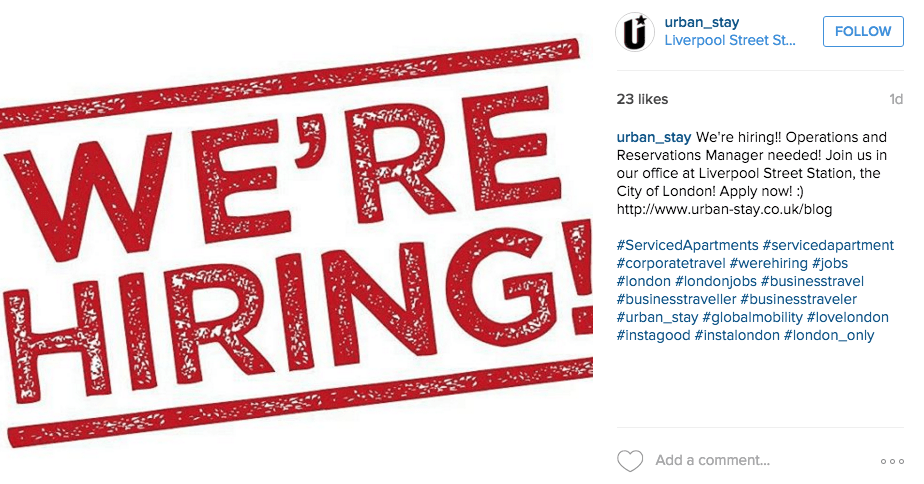

Twitter:
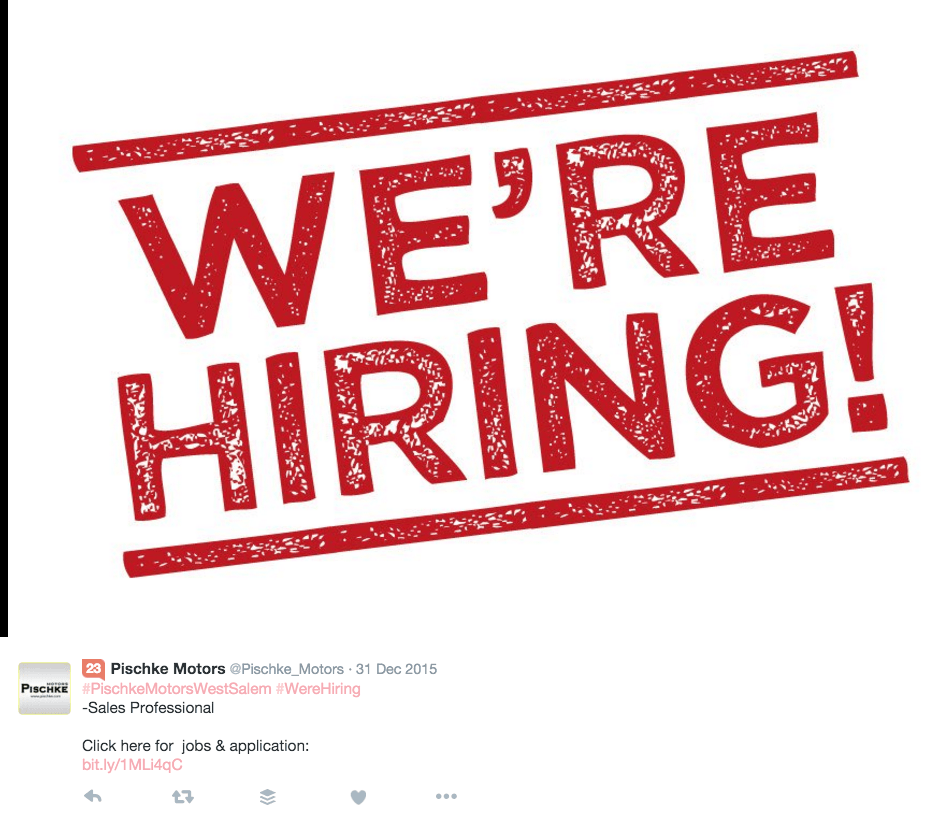
(Yep, multiple recruiters have used this image to accompany they’re “announcement”.)

LinkedIn:

Social media is a conversation. It’s not a soap box or a bulletin board, and neither should it be treated like one.
Try instead: Starting conversations
 In real life, if you wanted to start a conversation with potential candidates about a job you might start by asking them a question, telling a joke or talking about a recent event. You should be doing the same on social media.
In real life, if you wanted to start a conversation with potential candidates about a job you might start by asking them a question, telling a joke or talking about a recent event. You should be doing the same on social media.
One of the best and most recent examples of a recruiter using social media as a conversation starter, comes from Microsoft, who recently posted a brilliantly timed and executed job ad on their Microsoft Careers – Western Europe Facebook page. The ad, or should I say “letter”, was posted on December 15th (just before Christmas), and began with the infamous phrase “Dear Santa”. The “letter” then went on to explain what Microsoft would “really love for Christmas” (answer: Data Solution Architects), and how Santa will know them when he sees them. It’s a really lovely, timely post that even came complete with a drawing of a Christmas tree by a 5 year old girl.
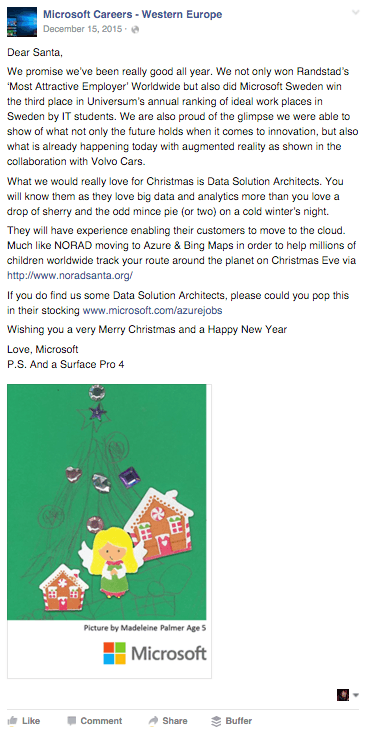
Bottom line: Use your social skills, not your shouting skills. Social media is your chance to engage with potential candidates on their level, not shout at them from on high.

